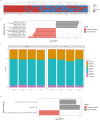High-quality metagenome-assembled genomes from proximal colonic microbiomes of synbiotic-treated korean native black pigs reveal changes in functional capacity
- PMID: 36109557
- PMCID: PMC9478101
- DOI: 10.1038/s41598-022-18503-2
High-quality metagenome-assembled genomes from proximal colonic microbiomes of synbiotic-treated korean native black pigs reveal changes in functional capacity
Abstract
Synbiotics are feed supplements with the potential to promote health and productivity in pigs partly, through modulation of the intestinal microbiome. Our study used shotgun sequencing and 16S rRNA gene sequencing techniques to characterize the effect of a synbiotic containing three Lactobacillus species and a fructo-oligosaccharide on the proximal colonic microbiome of 4- to 7-month-old Korean native black gilts. With shotgun sequencing we constructed unique metagenome-assembled genomes of gut microbiota in Native Black Pig for the first time, which we then used for downstream analysis. Results showed that synbiotic treatment did not alter microbial diversity and evenness within the proximal colons, but altered composition of some members of the Lactobacillaceae, Enterococcaceae and Streptococcaceae families. Functional analysis of the shotgun sequence data revealed 8 clusters of orthologous groups (COGs) that were differentially represented in the proximal colonic microbiomes of synbiotic-treated Jeju black pigs relative to controls. In conclusion, our results show that administering this synbiotic causes changes in the functional capacity of the proximal colonic microbiome of the Korean native black pig. This study improves our understanding of the potential impact of synbiotics on the colonic microbiome of Korean native black pigs.
© 2022. The Author(s).
Conflict of interest statement
The authors declare no competing interests.
Figures



Similar articles
-
Oropharyngeal, proximal colonic, and vaginal microbiomes of healthy Korean native black pig gilts.BMC Microbiol. 2023 Jan 5;23(1):3. doi: 10.1186/s12866-022-02743-3. BMC Microbiol. 2023. PMID: 36600197 Free PMC article.
-
Targeting the gut-lung axis by synbiotic feeding to infants in a randomized controlled trial.BMC Biol. 2023 Feb 20;21(1):38. doi: 10.1186/s12915-023-01531-3. BMC Biol. 2023. PMID: 36803508 Free PMC article. Clinical Trial.
-
Association between Altered Blood Parameters and Gut Microbiota after Synbiotic Intake in Healthy, Elderly Korean Women.Nutrients. 2020 Oct 12;12(10):3112. doi: 10.3390/nu12103112. Nutrients. 2020. PMID: 33053824 Free PMC article.
-
[Shotgun metagenome sequencing of Chinese gut microbiota: a review].Sheng Wu Gong Cheng Xue Bao. 2021 Nov 25;37(11):3717-3733. doi: 10.13345/j.cjb.210556. Sheng Wu Gong Cheng Xue Bao. 2021. PMID: 34841779 Review. Chinese.
-
The pig gut microbial diversity: Understanding the pig gut microbial ecology through the next generation high throughput sequencing.Vet Microbiol. 2015 Jun 12;177(3-4):242-51. doi: 10.1016/j.vetmic.2015.03.014. Epub 2015 Mar 23. Vet Microbiol. 2015. PMID: 25843944 Review.
Cited by
-
Metagenome-Assembled Genomes (MAGs): Advances, Challenges, and Ecological Insights.Microorganisms. 2025 Apr 25;13(5):985. doi: 10.3390/microorganisms13050985. Microorganisms. 2025. PMID: 40431158 Free PMC article. Review.
-
Characteristics of the Fecal Microbiome of Piglets with Diarrhea Identified Using Shotgun Metagenomics Sequencing.Animals (Basel). 2023 Jul 14;13(14):2303. doi: 10.3390/ani13142303. Animals (Basel). 2023. PMID: 37508080 Free PMC article.
References
-
- Ko K, Kim K, Huh J. Variations of wind speed in time on Jeju Island, Korea. Energy. 2010;35:3381–3387. doi: 10.1016/j.energy.2010.04.025. - DOI
Publication types
MeSH terms
Substances
LinkOut - more resources
Full Text Sources

